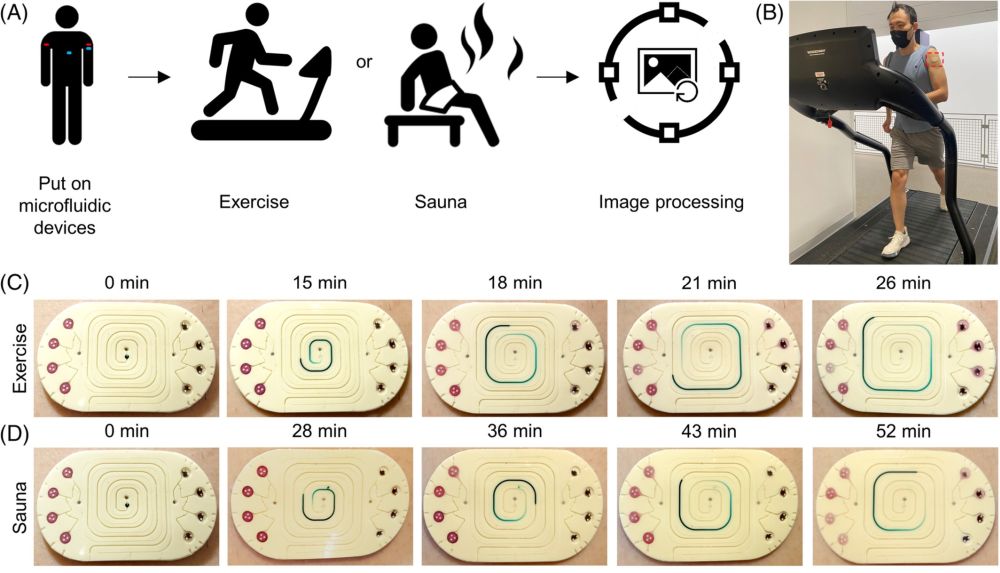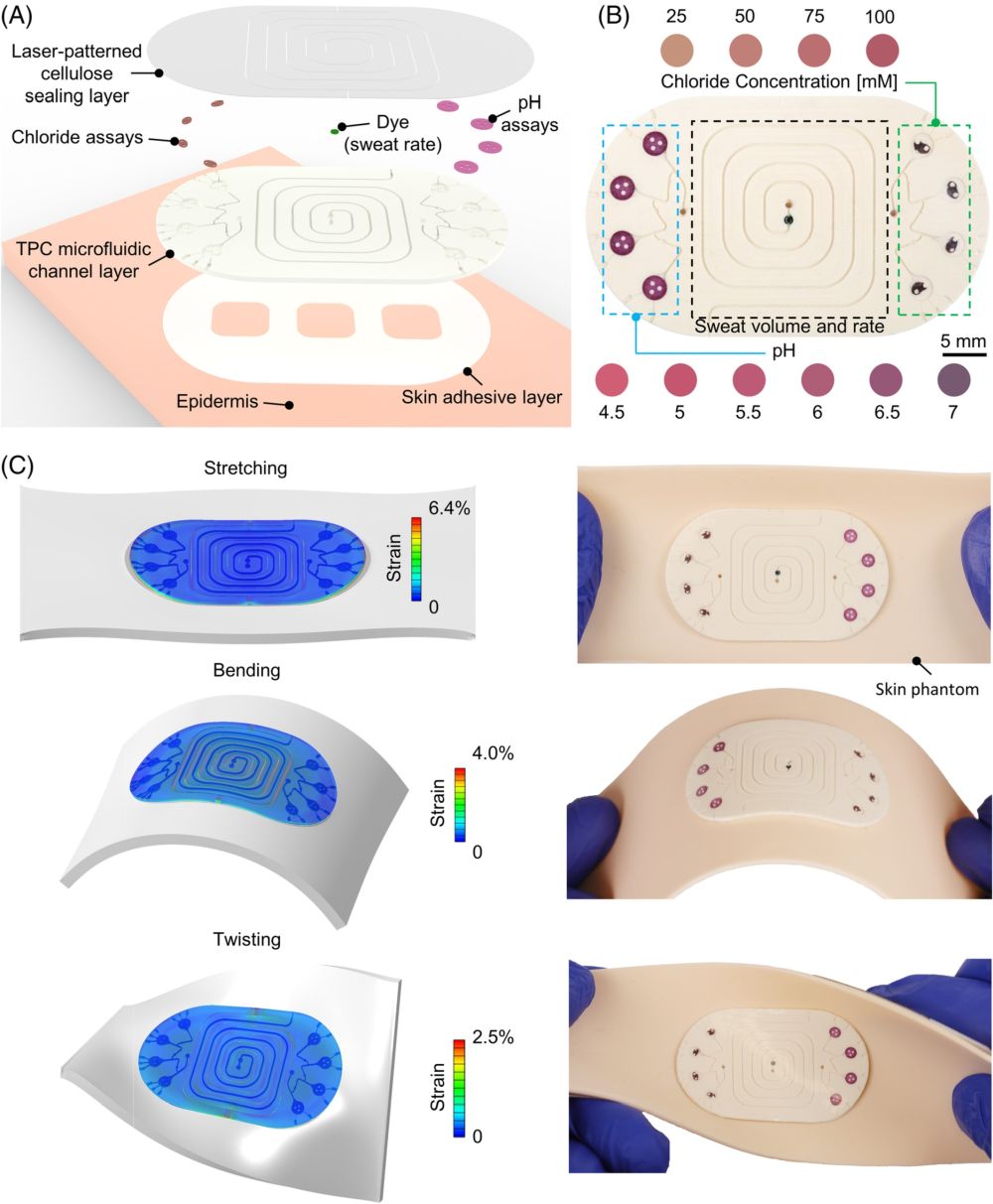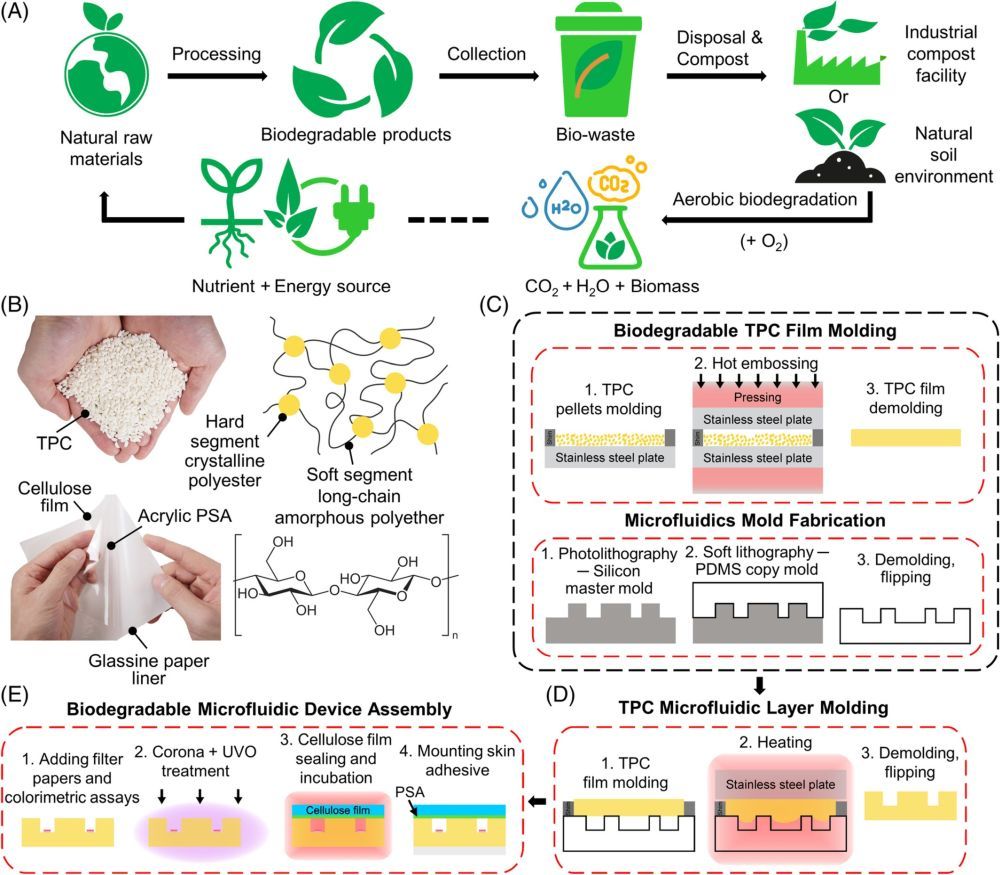
01 Sep Wearable chip detects sweat rate, sweat loss, and sweat biomarkers
Abstract
“Advanced capabilities in noninvasive, in situ monitoring of parameters related to sweat serve as the basis for obtaining real-time insights into human physiological state, health, and performance. Although recently reported classes of soft, skin-interfaced microfluidic systems support powerful functions in this context, most are designed as single-use disposables. As a result, associated waste streams have the potential to create adverse environmental impacts. Here, we introduce materials and fabrication techniques that bypass these concerns through biodegradable microfluidic systems with a full range of features, including measurement of sweat rate and total loss, and colorimetric analysis of biomarkers. The key components fully degrade through the enzymatic action of microorganisms in natural soil environments, or in industrial compost facilities, to yield end products with beneficial uses as fertilizers and species to improve soil health. Detailed characterization of the constituent materials, the fabrication procedures, the assembly processes, and the completed devices reveal a set of essential performance parameters that are comparable to, or even better than, those of non-degradable counterparts. Human subject studies illustrate the ability of these devices to acquire accurate measurements of sweat loss, sweat rate, pH, and chloride concentration during physical activities and thermal exposures.”

“Soft, environmentally biodegradable microfluidic devices for sweat capture, storage and biomarker analysis. (A) Exploded view schematic illustration of the key layers and components of a representative device. TPC: thermoplastic copolyester elastomer. (B) Optical image of a device that includes a microfluidic channel for sweat volume and rate measurement, and reservoirs with colorimetric assays for pH and chloride analysis. The color evolution of both assays occurs over physiologically relevant ranges of chloride and pH in human sweat. (C) Finite element analysis results and respective optical images of the devices on silicone skin phantoms during stretching (25%), bending (radius of curvature 35 mm), and twisting (90°).” Reproduced under Creative Commons Attribution 4.0 International License from , , , et al. Soft, environmentally degradable microfluidic devices for measurement of sweat rate and total sweat loss and for colorimetric analysis of sweat biomarkers. EcoMat. 2022;e12270.

“Material processing schemes, degradation mechanisms and fabrication methods. (A) Biodegradation process of biodegradable materials in natural soil environments, or in industrial compost facilities. (B) Pictures and chemical structures of a biodegradable thermoplastic copolyester elastomer (TPC) for the microfluidic layer and a cellulose film with an acrylic pressure-sensitive adhesive (PSA) for the sealing layer. (C–E) Illustration of the steps for device fabrication: (C) fabrication of a silicon master mold, a PDMS replica mold, and a molded TPC film; (D) fabrication of a TPC microfluidic layer; (E) assembly of a device by adding filter papers and colorimetric assays to the TPC microfluidic layer, bonding the cellulose sealing layer on top, and mounting onto a skin-compatible adhesive on the bottom.” Reproduced under Creative Commons Attribution 4.0 International License from , , , et al. Soft, environmentally degradable microfluidic devices for measurement of sweat rate and total sweat loss and for colorimetric analysis of sweat biomarkers. EcoMat. 2022;e12270.
Figures and the abstract are reproduced from , , , et al. Soft, environmentally degradable microfluidic devices for measurement of sweat rate and total sweat loss and for colorimetric analysis of sweat biomarkers. EcoMat. 2022;e12270. doi:10.1002/eom2.12270.
Read the original article: Soft, environmentally degradable microfluidic devices for measurement of sweat rate and total sweat loss and for colorimetric analysis of sweat biomarkers


